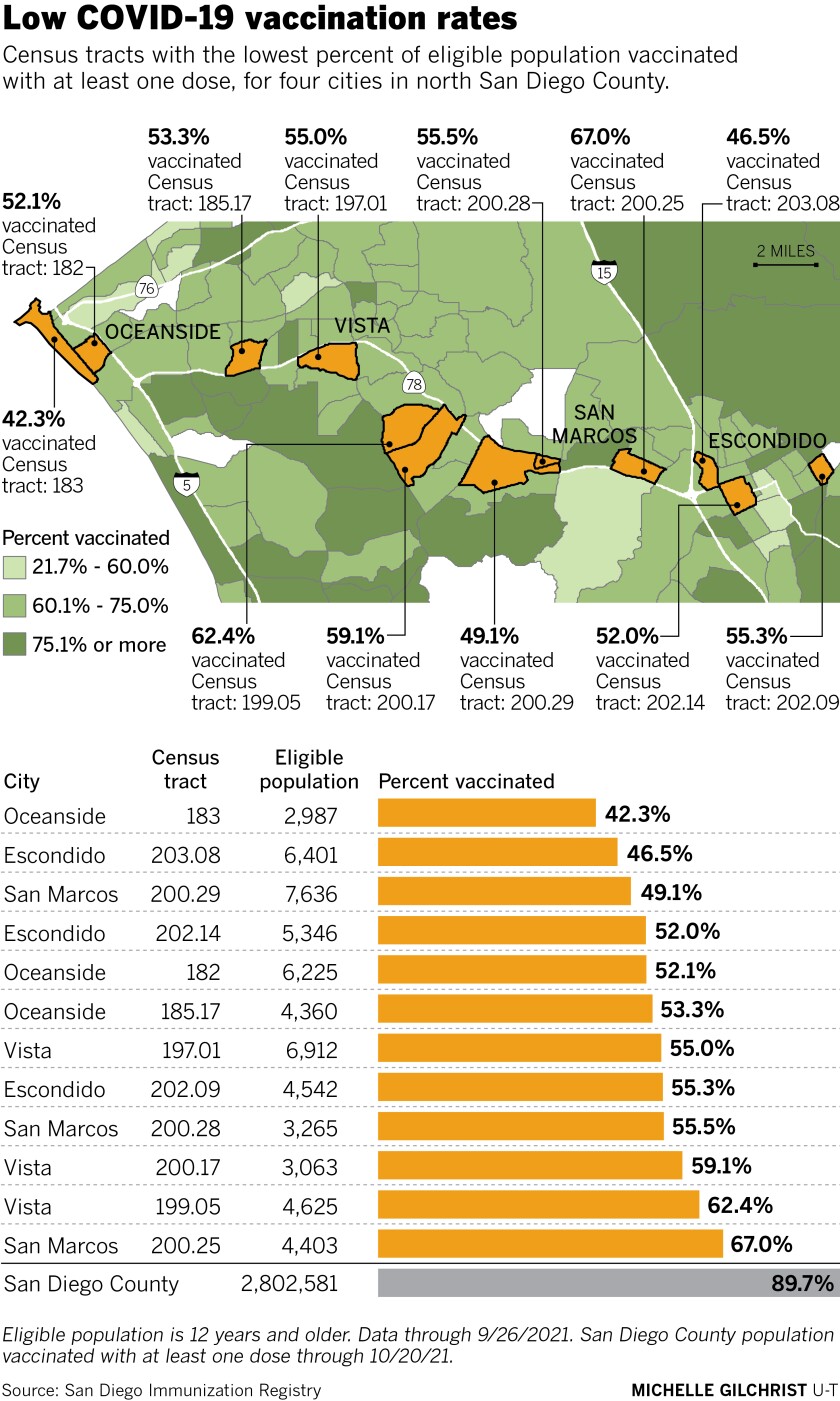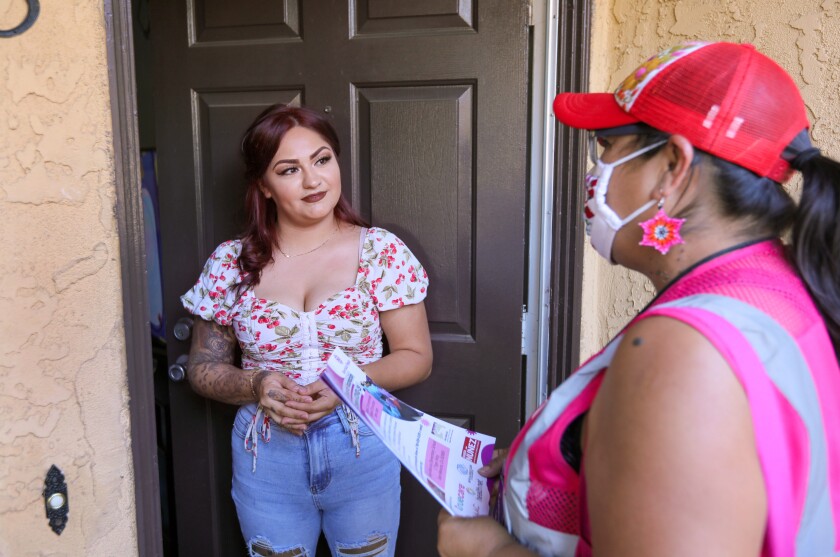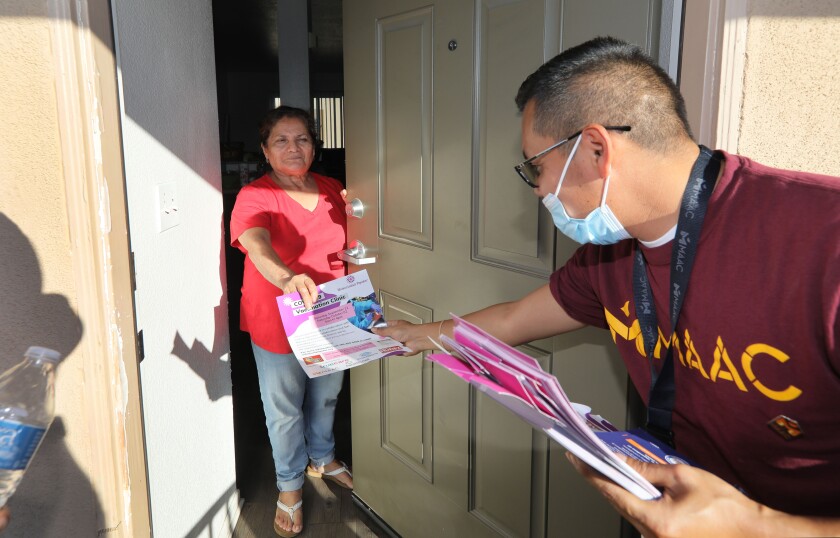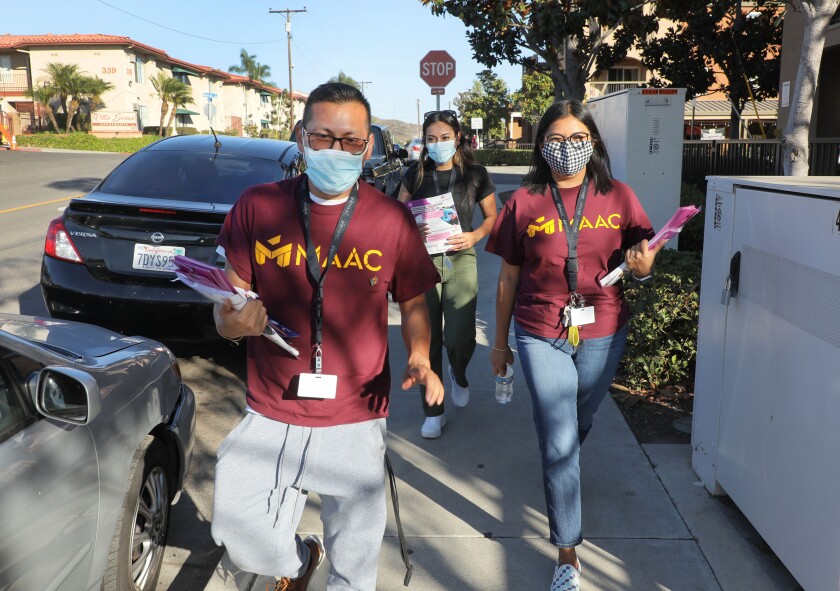San Marcos — A success story in one part of San Diego County is bringing scrutiny to another.
Now that vaccination rates among Latino communities in South San Diego County have risen well above the region’s average, some are questioning why the same isn’t true for Latino populations in North County neighborhoods.
Advocates and statistics analyzed by The San Diego Union-Tribune indicate that North County areas with high Latino populations are lagging behind in COVID vaccination rates.
“South Bay is at almost 89 percent” vaccinated, said community organizer Arcela Nunez-Alvarez. “But imagine, we have census tracts in Escondido, San Marcos and Vista that are barely hovering over 50 percent, and some are not even at 50 percent. That’s a huge disparity.”
As of late September, 87.6 percent of Latinos living in Chula Vista were fully vaccinated, according to county public health data, largely as a result of targeted efforts by health authorities, community organizations and local health advocates.

That compares with 51.1 percent vaccination rates in parts of North and East County that are heavily Latino. In Oceanside, one census tract had 42.3 percent of people only partially vaccinated, while Escondido and San Marcos had census tracts with 46.5 and 49.1 percent partially vaccinated, respectively.
“Escondido was one of the hardest hit cities in the entire county,” said Nunez-Alvarez, cofounder of the Vista-based immigration rights organization Universidad Popular. “It should have been one of the priorities for response, because the numbers merit that. But that wasn’t the sense of urgency we saw.”

Richmar neighborhood resident Carolina Lopez, left, listens to Arcela Nunez, Co-Founder/Co-Director of Universidad Popular, after Arcela came to her apartment door with information about the next days Covid-19 vaccination clinic to be held at nearby San Marcos Elementary School.
(Charlie Neuman / For The San Diego Union-Tribune)
Although people in other parts of San Diego sometimes associate North County with affluent, predominantly White coastal communities that have fared relatively well during the pandemic, the region includes some urban areas, sprawling suburbs and rural backcountry.
Escondido and Vista are majority Latino cities, with high numbers of immigrants, migrants and essential workers. According to 2019 estimates, Escondido’s population was almost 52 percent and Vista’s was nearly 52 percent Latino.
Escondido has been a hot spot of COVID-19 infections, with a rate of 13,210 cases per 100,000 residents on Oct. 20, well above the countywide rate of 10,371 and behind only Lemon Grove, National City, El Cajon and Chula Vista.
Early in the pandemic some health advocates noted that Latinos in San Diego County experienced higher COVID infection rates than other ethnic and racial groups, often because many were in jobs that were deemed “essential” and lived with multiple family members.
Hoping to stop COVID’s spread in hard hit areas like Chula Vista, Barrio Logan and City Heights, county authorities teamed up with the Latino Health Coalition, which is a group of nonprofits. They dispatched neighborhood representatives, including promotoras, who are neighborhood workers who walk door to door to educate residents about safety measures, testing and vaccination.
Health workers also distributed face masks, hand sanitizer and thermometers, and broadcast COVID information in Spanish while enlisting trusted community leaders to spread the message. Coalition members helped make vaccination appointments and organized testing and shot clinics in parks and schools.
Watching that coordinated effort, Nunez-Alvarez said she and her sister, San Marcos City Councilwoman Maria Nunez, were impressed by its efficiency but frustrated that similar resources weren’t directed at their communities.
“We knew that in South Bay, promotoras had been hired and trained,” Maria Nunez said. “We asked ‘Who’s contracted to do outreach and education here?’ But no one knew.”

Richmar neighborhood resident Octaviana Arango, left, receives a flyer from Maac Head Start program volunteer Rafael Lopez who came to her apartment door with information about the next dayOs Covid-19 vaccination clinic to be held at nearby San Marcos Elementary School.
(Charlie Neuman / For The San Diego Union-Tribune)
County officials said last week that they did not neglect North County; they just targeted resources first to areas with the highest infection rates. Those efforts created a template for the next phases of their community outreach, they said.
“The next region we expanded that to, frankly, was North County,” said Carey Riccitelli, who coordinates education and outreach for the county Emergency Operations Center. “We can’t be everywhere at once, but once we could reach out to North County, we did.”
County Supervisor Terra Lawson-Remer, whose district includes Escondido, pushed to open a vaccination center in downtown Escondido at the former Palomar Hospital site , said spokesman Spencer Katz. Lawson-Remer, a former healthcare worker, even gave shots.
“Thanks to her advocacy, Palomar Health in Escondido was stood up as a vaccination hub,” Katz said. “Prior to that, Escondido was left off the list of vaccination sites. The supervisor actually did a shift herself. It was the definition of a hands-on experience that was eye-opening for her and her team.”
The clinic also administered COVID-19 tests and monoclonal antibody treatments, Palomar Health spokesman Derryl Acosta said.
“That location was selected because of the harder-to-reach (populations), to create better access to the vaccine,” he said.
The Escondido hospital site delivered more than 30,000 vaccine doses before the shot clinic closed on May 1, due to dwindling attendance, Acosta said. Since then the health system has been providing vaccinations in the homes of people who can’t visit shot clinics.
Nunez-Alvarez said the shrinking lines at the clinic weren’t a sign of dwindling demand, but signals of a more challenging phase.
Though the hospital was centrally located, it still wasn’t accessible for many immigrants and migrant workers, she said. Some lacked transportation, couldn’t get time off work for vaccination or were nervous about being asked personal identification, she explained.
And with Latino communities more spread out in North County than in South County, it’s been challenging coming up with regionwide public health strategies, said Herminia Ramirez, program manager for outreach and migrant health with the Vista Community Clinic.
“I think North County has a very unique landscape,” Ramirez said. “We have much more diverse geographic locations. We’re very separated; there are a lot of people living in unincorporated areas. So I think resources need to be rolled out differently in North County.”
Early in their vaccination campaign, volunteers with Universidad Popular assisted the Cal Fire staff with shot clinics at North County farms, providing education and interpretation services, including multi-lingual translation of English, Spanish and Indigenous Central American languages.
“We would show up, and it would be mostly Guatemaltecos, who hardly spoke any Spanish,” Nunez-Alvarez said.
After helping with vaccine drives in the backcountry, she realized some people would never go to a large clinic. Instead, health authorities needed to bring the shot to them; the problem wasn’t vaccine hesitation, but logistics, she said.
“What we were hearing was all about access,” Nunez-Alvarez said. “‘Where do we go?’ ‘What do we need?’ ‘Do we need insurance?’ ‘What happens if I get sick and can’t go to work after I get my vaccine?’ Those were the questions we got. Not the politicized concerns that we see at the county Board of Supervisors.”
She and her team identified a key place for addressing these kinds of local concerns en masse — the Escondido World Marketplace. Often called the swap meet, the market is an emporium of food, clothes, antiques and housewares that attracts thousands of visitors a day, particularly on weekends.
“The Escondido World Marketplace is the place that every immigrant goes to,” Nunez-Alvarez said. “There were a lot of people there coming from Valley Center, Pauma, a lot of Indigenous migrants would come down.”
At the first event on May 16 organized with Cal Fire and Palomar Hospital, they administered shots to 350 patients.
“Many don’t have insurance, many were immigrants, even migrants, and many were farmworkers,” Nunez-Alvarez said. “So we knew we had found a way to reach a hard-to-reach community.”
Before a second swap meet clinic, scheduled on June 6, Palomar Health pulled out of the plan. Worried that would prevent people from getting second doses, Nunez-Alvarez dashed off letters to county officials.
“ It is unacceptable that the entire North Inland region, in particular the City of Escondido that was the third worst hit by COVID-19 in the county, has been underserved and neglected in this manner,” she wrote to Paola Martinez-Montes, director of community engagement for Board of Supervisors Chair Nathan Fletcher.
Cal Fire agreed to deliver the shots, and Martinez-Montes wrote back that she had requested authorization for the agency to hold vaccine clinics at the swap meet on that date and several others that month.
The events went on as planned, and vaccination efforts have continued at the popular site, Nunez-Alvarez said.
Acosta said the shift to Cal Fire was part of a planned transition, as Palomar Health closed out its county contract in May.
Maria Nunez also connected with other Latina elected leaders across the State Route 78 corridor, including Escondido Councilwoman Consuelo Martinez, Vista Councilwoman Corinna Contreras and Oceanside Mayor Esther Sanchez to press county officials for help, she said.

Rafael Lopez, Victoria Vasquez, and Nathalie Martinez, walk down Richmar Avenue to pass out flyers door to door with information about the next day’s Covid-19 vaccination clinic at nearby San Marcos Elementary School.
(Charlie Neuman / For The San Diego Union-Tribune)
In June 2021, the county contracted with community health organizations to do vaccine outreach and assistance in various geographic areas. Vista Community Clinic, South Bay Community Services and Maryland-based Global Communities were tasked with organizing in North County.
County officials said they invited Universidad Popular to apply for grants, but the organization declined. Nunez-Alvarez said her small, grassroots group didn’t meet the criteria for the larger projects.
Instead they continue canvassing North County neighborhoods as volunteers. On a recent FridayNunez-Alvarez teamed up with San Marcos Councilman Randy Walton and community organizers with the Metropolitan Area Advisory Committee to notify apartment residents of a vaccine clinic at San Marcos Elementary School the next day.
A number of people said they had already gotten vaccines, and several acknowledged that they had been ill with COVID-19. A few asked about booster shots.
One man confessed that he hadn’t gotten vaccinated because he fears needles.
The vaccine clinic would offer the one-dose Johnson & Johnson shot, Nunez-Alvarez said, cheerfully chipping away at his hesitation.
"behind" - Google News
October 24, 2021 at 07:00PM
https://ift.tt/3vHAuUx
Why is North County falling behind in vaccinating Latinos? - The San Diego Union-Tribune
"behind" - Google News
https://ift.tt/2YqUhZP
https://ift.tt/2yko4c8
Bagikan Berita Ini














0 Response to "Why is North County falling behind in vaccinating Latinos? - The San Diego Union-Tribune"
Post a Comment